Reforms allowing private operators to manage their own rail fleets look set to have a big impact on how Indian carmakers transport their vehicles.
Worry lines are clearly discernible on the face of G. Subramanian, chief executive of Cargo Wings Madras. Ever-rising fuel and toll costs are cutting into already wafer thin margins at his car haulier business. Meanwhile, with India’s vehicle market in the doldrums, OEM customers are reluctant to consider hikes in freight rates. Vehicle logistics has become so challenging that the Chennai-based veteran has quietly sold half his business to TVS Logistics.
Now, the prospect of losing more volume to rail is causing Subramanian sleepless nights. That might sound surprising in a country where rail currently accounts for no more than 5% of all vehicle movements. However, India’s rail reforms, known as the Automotive Freight Train Operator (AFTO) policy, will allow private operators to manage their own fleets of rail wagons. So far, Maruti Suzuki and joint venture APL Logistics Vascor have jumped into the fray. Letters of intent have already gone out to wagon manufacturers Texmaco (for APL Vascor) and Titagarh Wagons (for Maruti Suzuki) for a minimum of three rakes each. According to Bill Villalon, senior vice-president of global automotive at APL Logistics, as well as chairman of APL Logistics Vascor, services could launch as early as the third quarter of this year.
The new rakes, whose designs have been approved by the design arms of the state-owned Indian Railways, will increase rake capacity from 125 vehicles to more than 300. “We are doomed,” says Subramanian.
Read these other features that make up this special report:
Two thousand kilometres away, Achal Paliwal, head of exports and logistics at Honda Cars India, is as jubilant as Subramanian is worried. “Strategically speaking, today [Honda’s] finished vehicle movement is 100% dependent on road,” he says. “Given the road conditions and environmental impact of carbon emissions, we need to find a viable alternative. Railways will be the best option.”
Paliwal says Honda will be among the first to use APL Vascor’s service, especially for vehicles moving from its plant in Greater Noida, near Delhi, to the south of India. “Our exports are routed via Ennore port in Tamil Nadu and we would like to experiment with that route to begin with,” says Paliwal, who reckons he can book a rake a week for exports. He adds that he would like to see door-to-door services for rail.
This enthusiasm bodes well for the American joint venture, which is currently the only player to gain a licence outside Maruti. APL Logistics, a subsidiary of Neptune Lines, and Vascor, itself a joint venture between APL Logistics and Japan’s Fujitrans, became interested in the market after APL Logistics ran some container operations by rail between Delhi and Mumbai, says Villalon.
A tough, but good business to be in
While the expectation is that rail services will benefit from the policy change and the new investment, there are concerns over rail services in India, including the priority given to passenger movement as well as commodities and bulk goods like coal, fertiliser and steel. Sajal Mittra, a railway veteran who is now director of Blupith Consultancy, admits that Indian Railways is unlikely to compromise these priorities for goods like cars, which are usually moved at a cheaper rate.
"Of course, food grains and essential commodities will have priority, as exists in China. However, there is room for accommodation of automotive movement on rail, I trust" - Bill Villalon, APL Logistics
“However, as it is in the government sector, [Indian Railways] may be willing to look at a reasonable rate and reasonable amount of traffic just to cater to the automobile sector,” he reasons.
Villalon is also optimistic. “Our container operations on rail did not pose any challenge,” he points out. “I strongly believe there is government support for this initiative. Of course, food grains and essential commodities will have priority, as exists in China. However, there is room for accommodation of automotive movement on rail, I trust.” [sam_ad id=6 codes='true']
Bill Garrett, chief executive officer of both Vascor logistics and the APL Vascor joint venture, also dismisses fears surrounding Indian Railways’ pricing and track dependability. “It’s a good business for [Indian Railways] as well,” he says. “Overall cost effectiveness will be the determining factor.”
By its nature, rail requires more handling and switching than road, increasing the potential for damage. However, the improved wagon designs are expected to reduce damage as well as increase capacity. Scheduled runs will also be a challenge, given that OEMs bunch sales towards the month end, concedes APL Vascor India’s chief operating officer, Umesh Bhanot. “We are in discussion with OEMs to spread their dispatches to match fixed runs,” he says.
Honda’s Paliwal even suggests that the costs for railway logistics will eventually be lower than for road. “We are agreeable to par rates [with road] for rail movement,” he says. “Having said that, with the large volumes [rail] is predicted to carry, the chances of costs being below road movement are bright.”
Another issue is that OEMs have to pay for an entire rake, whether they use 10% or 100% of its capacity. “Currently, the railways don’t care if you pack 10 or 120 cars,” says WWL India’s managing director Gur-Prasad Kohli. “It will charge you for the entire rake. Then, it gives you seven hours to load and get out. That’s not easy to manage.”
"We are agreeable to par rates [with road] for rail movement,” he says. “Having said that, with the large volumes [rail] is predicted to carry, the chances of costs being below road movement are bright" - Achal Paliwal, Honda Cars India
As a result, carmakers need to look more closely at collaboration in stockyards and transport, something relatively uncommon in the sector today. Again, Villalon believes that price and service will win out, and OEMs in India will be willing to share rail assets. For example, Paliwal says he would be willing to explore rail distribution in the northeast provided other OEMs are ready for a “collaborative logistics arrangement” to share rakes.
Maruti says ‘mine alone’
On the other hand, Maruti Suzuki appears to have shunned the idea of collaboration for rail transport. At the end of last year, the carmaker’s chairman, R.C. Bhargava, told the Hindu Business Line that the company would use its rail wagons exclusively, despite the fact that its production is based only in the north of the country. According to Hyundai Motor India’s Anand Venkateswaran, general manager for sales logistics, this decision is a “national waste” since a rake returning empty strains capacity, particularly in the south of India where there are fewer direct freight corridors.

Sajith Sivam, senior manager at Glovis India, the logistics arm of Hyundai, also understands this logic, but says it will hurt the industry. “Maruti is justified in its ‘mine only’ policy. We would have done the same if we had a choice,” he says, “but this move will impact all auto OEMs. Fleet availability will come down in the south and lead to unhealthy competition among OEMs to garner available fleets.”
Venkateswaran believes the move could even end up hurting Maruti indirectly through higher transport costs. “I would say that there would be a displacement of transport companies operating with Maruti and many of them may shift bases down. If you look at the south, we have Toyota, Ford, Hyundai and Nissan; put together it is a competing force with Maruti. If Maruti has 50% share, the others together have another 50%.
“In the short run, freight costs could go up, but in the next three years or so, when rail movement picks up and people start seeing the advantage of rail, then it will stabilise,” he says.
Many believe Maruti is unlikely to return its rakes empty. According to Mittra, the carmaker might move components from the south on these return trips. Otherwise, it may even offer a premium rate service to rivals. Finally, it may well run empty just to corner the market. “Everything is possible. [Maruti Suzuki has] done the mathematics well and is not likely to allow revenue leakage,” he says.
Others are less certain the carmaker will really go it alone. WWL’s Kohli suggests Maruti might use a 3PL to build up a return load on the way back. He suggests that if other OEMs were willing to buy space, Maruti would be open to collaboration. Mercurio Pallia Logistics chairman Vipul Nanda believes an emtpy backhaul would be unthinkable. “Nobody knows Maruti’s gameplan. Let’s not jump to wrong conclusions,” he warns.
Honda’s Achal Paliwal agrees. “Maruti Suzuki can afford to say [it will not share its wagons], but rules of economics do not prefer such practices,” he says. “If there is an asset it has to be put to optimum use. However, I am reasonably sure that [Maruti] has not revealed its grand plan in full.”

For the time being at least, Maruti’s decision has left APL Vascor as the only current permit holder under the AFTO policy. “We have the first movers’ advantage,” admits Umesh Bhanot.
Villalon does not believe, however, that the company will be alone for long. “Others will join. Maybe they are evaluating,” he says. “That’s natural. It is early days.”
Mahindra Logistics has already been handling both tractors and passenger cars by rail in India for several years. According to Sushil Rathi, vice-president of supply chain management, the logistics provider manages two or three rakes per month for Hyundai to the northeast, including first and last-mile connectivity by road. It has seen more rail volume in Mahindra’s tractor output, moving almost 20,000 tractors by rail every month to several destinations since 2007. Mahindra & Mahindra Automotive’s passenger vehicles are railed from Haridwar, in northern India, and from Mumbai to various locations in eastern India using four or five rakes per month.
However, Rathi rules out Mahindra Logistics acquiring its own AFTO licence in the short term. “The railway option is economical only for OEMs with stockyards and for long distance movements,” he says. “For a direct delivery model this is not economical, while multiple loading and unloading can lead to transit quality issues.”
There are other potential rail players in India, including DB Schenker, owned by the German railways, and Mercurio Pallia, whose parent Gefco is controlled by RZD Russian Railways. These companies are being careful, however, particularly in the current market. Mercurio Pallia’s Vipul Nanda, for example, says India’s falling vehicle sales “made us stop in our tracks” for rail. However, the company has signed an agreement with logistics provider ETA Freightstar to move containerised cars on rails.
“First and foremost, we are car carriers on road,” says Nanda. “Therefore, we need to feed our fleet. Any excess will automatically spill over onto proposed rail business in partnership with ETA Freightstar.”
"Today, neither are there the volumes, nor the balance between different clusters, nor the OEMs coming with that kind of enthusiasm for [Glovis] to initiate any action" - Anand Venkateswaran, Hyundai Motor India
Arnaud Cauchy, managing director of Gefco India, also agrees that the time is not yet ripe for the company to go the AFTO route. “We will wait and watch, before taking a call, how Maruti and APL Vascor handle it,” he says.
Hyundai’s Venkateswaran also anticipates more global operators will enter the market, although he rules out Hyundai making any Maruti-style direct investment in rail wagons. While Glovis would be a candidate, he also doesn’t see it happening for several more years, largely because of the risk of empty return flows. “Today, neither are there the volumes, nor the balance between different clusters, nor the OEMs coming with that kind of enthusiasm for [Glovis] to initiate any action,” he concludes.
Glovis India’s Sivam says that getting a licence to run rakes is not an issue for the company, but he admits that running rail services profitably would be tough.
Hyundai tries new services
Nevertheless, Hyundai Motors has been trying to increase its current rail options ahead of the new AFTO services. The carmaker has already been relying on TCI Supply Chain Solutions and Mahindra Logistics for rail services, and recently added Glovis to the mix. The logistics provider is trying out a service from Chennai, close to Hyundai’s plant, to Ahmedabad in the northwestern state of Gujarat. Sivam has also roped in Nissan for this route. He admits that it will be difficult to return full, but with Gujarat emerging as an automotive hub, Sivam sees potential for balance eventually. In the meantime, the service will have to route to other regions on the return leg.

Hyundai has nevertheless seen advantages to using rail, particularly in transit times. For long distance moves, for example, the carmaker could save as much as 11 days. If you consider borrowing costs of around 15% for dealers in India, this saving is substantial for inventory holding. There is less benefit, however, for logistics costs.
“We unfortunately are unable to derive benefit in terms of logistics costs at the moment because the freight structure of the railways currently is not favorable towards movement by rail,” says Venkateswaran. “However, in the case of Guwahati [in the northeast], where the distance is more than 2,500km, it is breaking even with road transport. Service providers make a small margin, but that is just enough to keep them going.”
Pushed onto the tracks
There are a number of factors that could push Indian manufacturers towards rail regardless of the AFTO reforms. India’s dependence on imported oil, as well as the current cost of its diesel subsidy, could make road costs unsustainable, according to WWL’s Kohli. “The day is not far off when there will be parity between diesel and petrol,” he predicts. “When that happens, there will be no advantage in trucking finished vehicles 2,500km.”
Kohli also emphasises that the implementation of India’s long awaited Goods and Service Tax (GST), a value-added tax intended to centralise many state and local taxes, would also make rail more attractive. With GST, OEMs would be able to stock vehicles in larger distribution yards and then move by rail. “The minute GST comes in you don’t need any more long distance trucking; you can shift down to move cars, trucks, buses and tractors by rail, stock them in one particular stockyard in the north, one in the west and from there you can do short lag distribution,” says Kohli.
"The OEM response has been very good. Even the government has gone out of its way to understand the nuances of this mode of transport and made the policy more attractive for potential investors. " - Umesh Bhanot, APL Vascor
He admits that India will have to develop more dedicated vehicle yards if its rail network is to truly flourish for automotive. “We need storage yards plus PDI facilities at these points,” he says.
Carmakers are also increasingly committed to reducing carbon emissions, for which rail transport can play a serious role. Also, unlike road in India, rail movement isn’t plagued by interstate border crossings, corruption on highways or varying laws on truck sizes.
Hyundai’s Venkateswaran predicts that 10% of its vehicle volumes will move by rail with the next three years. Maruti has said that 30% of its volumes will move by rail in the next five. By 2020, when the passenger car market in India is expected to reach 5m units, there are expectations that 25% of vehicles will move on rail. At that point, Villalon says APL Vascor would need around 100 rakes. “Rail is the future, but don’t be impatient,” Venkateswaran warns.
At APL Vascor India, Bhanot is sure that the transition to rail is heading in the right direction. “The OEM response has been very good,” he says. “Even the government has gone out of its way to understand the nuances of this mode of transport and made the policy more attractive for potential investors.”
Bhanot also adds words of comfort to G. Subramanian of Cargo Wings Madras, who fears the train’s rumble could be the death knell for many road carriers in India. Bhanot is sure the growth of rail won’t signal the end for road carriers. “Long hauls by rail and short hauls, as well as first and last mile by road, will emerge as the new transport wisdom,” he says.

























![Global[1]](https://d3n5uof8vony13.cloudfront.net/Pictures/web/a/d/s/global1_726550.svgz)










